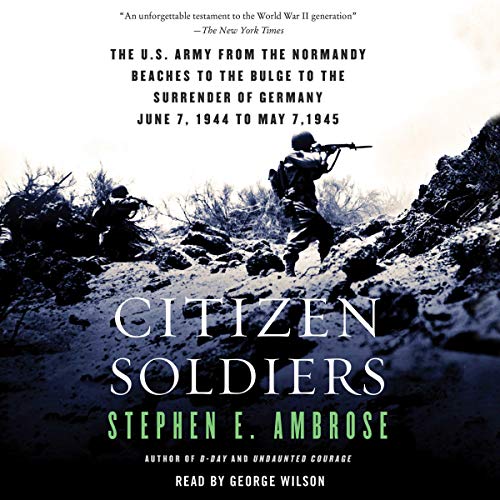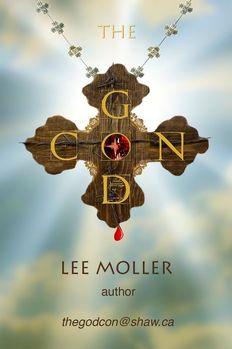Citizen Soldier; Stephen E. Ambrose; 1997; Simon and Schuster; 492 pgs; notes, index, photos22/5/2021  I learned a lot from this book, perhaps more than any other, at least about the human side of the fighting. I recommend it. Ambrose is a World War II historian. I recall seeing him interviewed in the excellent series The World at War, narrated by Laurence Olivier. He died young at the age of 66. The book starts at D-Day, June 6, 1944, and ends May the 8th 1945 (VE Day). Before I tuck into my summary, a note for my Danish relatives. Denmark was overrun very early in the war. The Danes were ultimately "liberated" by Montgomery. I used quotes around the word because the Germans marched out of Denmark on their own steam. Why was Monty diverted away from Berlin and the main action? Because at the Yalta Conference, the fate of most European states was decided… most, but not all. Excepted, among others, were Austria and Denmark. These countries were essentially up for grabs. Had the allies not entered Denmark, the Russians would have. Denmark would have been behind the iron curtain and the future for all the Danes, including my family, would have been much worse. I certainly would not be living the good life as a Canadian. Monty was a dick, but he was a useful dick. As the title of the book implies, it is about the experiences of the common (mostly American) soldier and their fight to win and to survive. The book also examines the experiences of the German soldier, as well as nurses, medics, pilots and other front line troops. I am awed by what these young men had to put up with. Weeks between hot meals or showers. Living in a foxhole dug out of frozen earth, cold and miserable, afraid of the slightest little escaping flash of light that might make the artillery rain down on then. Very few men made it from D-Day to VE day intact. Many units would suffer more 250% casualties! This can happen because replacements were constantly arriving from the States. By the time of the Battle of the Bulge, a rookie would arrive, dig in, and fight. If he was still alive in a week, he was a combat veteran who had to teach newer rookies how to not get killed. If you ever see anyone smoke a cigarette with the filter pointing out of the fingers, and the lit end near the palm of the hand, they were probably in combat at some time. Battle fatigue (also called "shell shock") was common and basically a new phenomenon. In prior conflicts, you would generally be dead before you fell victim to shell shock. We call it PTSD today. By D-Day, the allies controlled the skies over Europe. The P47 Thunderbolt was a fighter/bomber that was to slow to act as a front line fighter. Instead, P47s did close ground support and pin point bombing. They typically carried a rack of missiles that could easily take out a Tiger tank. The Germans hated them. They referred to them as Jabos: taken from "Jager", which means hunter in German; and "Bomber". Piper Cubs (small, two seater, single engine airplanes) roamed the field of battle, giving accurate intel on the enemy's positions. Woe betide the German on the ground who shot at a Piper Cub. Within minutes of doing so, the area would be saturated with allied artillery. Unfortunately, the Piper Cubs did not see the build up prior to the Battle of the Bulge. The French hedgerows were a major issue for the allies. Arial photos were taken from directly overhead, masking the issues created by the hedgerows. The Germans were well prepared for the allies. A common tactic was to let a tank rumble out into a hedgerow field. It would soak up small arms fire and retreat. And then mortars would rain down on the now revealed allied locations. It took many weeks for the allies to formulate new tactics and modify Sherman tanks to break through the hedgerows. The Sherman was an excellent tank. Rugged, reliable and fixable in the field. This was not so for the more powerful German tanks. And the allies had many, many more tanks than the Germans. The (American designed!) T-34 Russian tank was perhaps the best tank of the war. German tanks and artillery fired far more dud rounds than did other armies, largely because the slave laborers who made them had mastered the art of sabotaging them without being detected. The book then follows the order of battle from D-Day, through the Falaise pocket where many Germans were trapped, and towards the Siegfried Line. The Siegfried line ran the western border of Germany. Pill boxes, dragon's teeth (large concrete blocks used to block tanks), and pre-sited artillery made for tough going for the allies. The Battle of the Bulge was the most costly battle ever fought by the Americans (I think Gettysburg was the second most costly). The winter was bitterly cold, and troops spent days in fox holes trying to stay warm and avoid trench foot. Famously, the Germans parachuted some 500 American-savvy spies lead by Otto Skorzeny in behind the US lines. The tactic paid off big time. They sewed confusion wherever the went, messing with signs and directing traffic in the wrong direction. Each GI carried an ID card in addition to his dog tags. The title on the card read "Not a Pass -- for Indentification (sic) Only". The ever perfectionist German forgers corrected the typo! One German spy was lined up against a wall and shot when a smart MP noticed the error (or rather, the lack of it). Another trick the Americans used was to ask a possible spy what his shirt size was. In America, shirt sizes were measured in inches, not centimeters. Many Germans either forgot the difference or were too slow trying to do the math in their heads. And again, they were lined up against a wall and shot. The Battle of the Bulge finished as soon as the weather broke and the Jabos had clear targets. But it was still a long fight just to get to the German border. The Americans learned that captured US flier POWs were treat better if they were officers rather than enlisted men. As a result, the Air Force promoted all its enlisted fliers to sergeants. Only one deserter, Pvt Eddie Slovick, went through the entire court martial process in the US Army. He was shot. Most deserters were just put back on the line. For comparison, the Nazis shot 50,000 deserters in the ETO (European Theater of Operations). Black soldiers were treated very badly. For example, German POWs got better treatment than wounded black veterans, especially in the southern US. They could use the whites only fountain; sit in the whites only area of the local theaters; and enter whites only stores. In January, 1945, Montgomery sent a letter to Eisenhower basically saying that Ike was doing a poor job, and that he should be given overall command of all ETO forces on the ground. Eisenhower wasted no time in putting Monty in his place. His reply had obvious implications: Shut up; the US is the driving force; and he was in charge. This was not the first time Monty tried a major power grab. The fact is, Monty was not good at his job. When things went well, it was all about him, and when they went south, it was someone else's fault. Operation Market Garden, his plan, was a straight up disaster. Monty decided to toe the line and follow orders. In one self serving press release, Monty tried to paint a picture of the British coming to the rescue of the Americans during the Battle of the Bulge, and his brilliant strategies that made it happen. In fact, the opposite was true, and the Americans were outraged. Monty was a glory seeker extraordinaire, and a political albatross. The Germans were in a fighting retreat after the Rhine was crossed. In one hamlet, a burgher, who knew what American fire power was likely to do to his town, pleaded with a German officer to move his troops to a town that was already in ruins. He was so persistent that the officer asked where he lived. He pointed out his home. The officer ordered a mortar crew to set up next to his house, launch five fast rounds at the Americans, and scoot. Ten minutes later, the burgher's home was a smoking ruin. After crossing the Rhine, the progress towards the heart of Germany escalated. The fate of European countries was settled at Yalta. Patton and others wanted to drive to Berlin, but that was left to the Russians who desperately wanted the glory. If the Russians had been smart, they would have surrounded the city with artillery and pounded it until everyone gave up. Instead, they charged in and suffered a terrible toll in soldier's lives. As previously noted, some countries were not marked for the East or the West at Yalta. Denmark was one of them. If the Russians had surrounded Berlin, they could have proceeded west and north and "liberated" Denmark. After the war, some GIs were exchanging stories. An artillery crew recounted a funny story about how they had once been asked to target and destroy a haystack, which they did. Fifty three years later they met the man who had order the strike. He had seen the haystack move from a Piper Cub. He informed the artillery crew that they had, in fact, killed a disguised Panther tank. Generally speaking, in Europe, and especially Germany , the Americans were well received. This cannot be said for the Soviet troops. The Americans showed up with smiles and chocolate bars. The Russians were more into rape and revenge. This is one of the best books about man's greatest war to date. It is a well written and intimate look at the experiences of US soldiers. We owe the soldiers from all the powers that fought Germany a debt that cannot be repaid.
0 Comments
Leave a Reply. |
AuthorLee Moller is a life-long skeptic and atheist and the author of The God Con. Archives
May 2024
Categories
All
|

 RSS Feed
RSS Feed